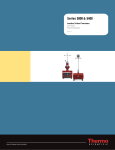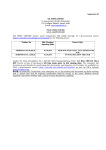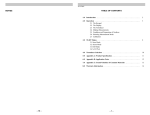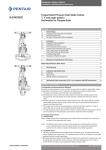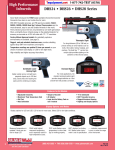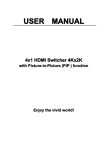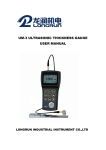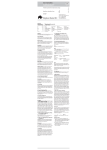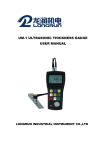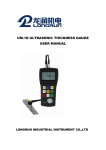Download SECTION B1: MACHINE COMPONENTS
Transcript
SECTION B1: MACHINE COMPONENTS The machine portion of the Injected Metal Assembly system provides the means for: • holding, heating and injecting the alloy; • distributing and controlling electrical, pneumatic, coolant, drain, lubrication and gas services; • holding and controlling the motion of the Cable Processor Module and tooling. A brief description of the machine components will provide an understanding of the various functions of the machine. Control panel CPM-1 Injected Metal Assembly™ System ref 020718 B1-1 The control panel, mounted on the front of the electrical enclosure, houses • • • • all push buttons and indicator lights the operator interface module the temperature controller the cycle counter. Note that individual push buttons and selector switches may vary depending on the termination or small component assemblies being produced, and the operating sequence. Push buttons Alarm Reset illuminated push button In the event that one of the limit or proximity switches fails during the cycle, the Alarm Reset illuminated push button will illuminate. Pressing the Alarm Reset illuminated push button will reset the alarm. When the light is illuminated, it usually means that one of the switches failed to open. See Section G5: Troubleshooting for more information on how to determine which switch is not functioning correctly after the light illuminates. Control On illuminated push button Used to turn the Master Control Relay (MCR) on. The push button illuminates when the MCR is on. The control power must be on to operate the system. Ejector illuminated push button Illuminates when the Ejector pneumatic valve is energised. May be used to manually energise the valve in setup mode. Head Close illuminated push button Illuminates when the Cable Processor Module Close pneumatic valve is energised. May be used to manually energise the valve in setup mode. Head Open illuminated push button Illuminates when the Cable Processor Module Open pneumatic valve is energised. May be used to manually energise the valve in setup mode. Lubricate illuminated push button Illuminates when the Lubricate pneumatic valve is energised. May be used to manually energise the valve. Mechanism Retract/Advance illuminated push buttons Illuminates when the Moving Mechanism pneumatic valve is energised. May be used to manually advance/retract the moving mechanism in setup mode. CPM-1 Injected Metal Assembly™ System ref 020718 B1-2 Melt Pot On/Off selector switch Used to turn the melt pot on and off. The selector switch is generally left in the on position, and the time switch is used to energise the melt pot. The selector switch must be in the on position during production. Setup/Manual/Automatic key selector switch Used to select the setup, manual or automatic mode. In the setup position, the control panel illuminated push buttons may be used to energise their respective pneumatic valves. The system will not cycle with the selector switch in the setup position. The injection cannot be turned on in the setup position. In the manual position, the system control will allow individual system cycles to be run using the Start push button. In the automatic position, the system control will allow system cycles to be run without depressing the Start push button. The cycle is started when the Cable Processor Module Closed proximity switch closes. CAUTION! The key for the Setup/Manual/Automatic key selector switch should not be left in the switch. Only authorized personnel should have access to the key. Torch Off push button Used to turn the torch off. Torch On illuminated push button Used to turn the torch (nozzle heater) on. The torch must be lit manually with a suitable device. The torch must be on and the air/gas mixture must be ignited when the system is in production. Operator Interface module The operator interface module is used to access all Programmable Logic Controller functions. The status of inputs (ie. proximity switches, selector switches, push buttons, etc.), outputs and internal status bits can be seen using the module. Timers can be adjusted using the module, but the sequence of operation cannot be changed using the operator interface module. A user’s manual for the module is inside the machine cabinet in the drawing holder. CPM-1 Injected Metal Assembly™ System ref 020718 B1-3 Melt pot temperature controller The melt pot controller is a Watlow Series 965. A user’s manual for the controller was shipped inside the machine cabinet in the drawing holder. Cycle counter The cycle counter indicates the number of injection cycles the machine has made. The counter does not operate when the injection is off. Counter instructions are included in Section J: Vendor Supplied Specifications and Maintenance Bulletins. Injection unit The injection unit is a piston type pump, with the gooseneck portion submerged in the alloy. The injection unit is activated by the Injection cylinder. CPM-1 Injected Metal Assembly™ System ref 020718 B1-4 Gooseneck assembly The gooseneck assembly consists of the injection sleeve pressed into the gooseneck casting. Gooseneck The gooseneck is a machined steel casting which holds the injection sleeve. A threaded top section allows for the installation of the injection nozzle. A machined passage allows alloy to flow from the bottom of the injection sleeve to the nozzle. Injection sleeve A stellite injection sleeve, pressed into the gooseneck, is accurately machined to a close tolerance fit with the injection plunger. This close fit ensures that the injection unit can develop adequate alloy pressure during the injection cycle. Fill slot The fill slot is machined in the injection sleeve and a corresponding hole is machined in the gooseneck. This allows the injection unit to refill with alloy between injection cycles. Y-bracket The Y-bracket, attached to the melt pot frame, supports the gooseneck assembly. Plunger The stellite plunger, driven by the injection cylinder, pumps the molten alloy from the gooseneck assembly into the tool cavity. The close tolerance fit between the plunger and the injection sleeve ensures that the injection unit can develop adequate alloy pressure during the injection cycle. Link The link connects the plunger to the injection lever. Injection lever The injection lever couples the plunger to the Injection cylinder, allowing the plunger to be advanced and retracted during the injection cycle. Injection cylinder The pneumatic Injection cylinder drives the plunger during the injection cycle. Injection nozzle The nozzle is seated in the gooseneck. It is the means by which alloy is transferred from the pump to the tool. The end of the nozzle has a precision ground tip which seals on the nozzle seat portion of the tool. CPM-1 Injected Metal Assembly™ System ref 020718 B1-5 Fill gap With the plunger in its fully retracted position, the distance between the bottom of the plunger and the bottom of the fill slot in the injection sleeve is referred to as the fill gap. The fill gap is adjusted by moving the position of the clevis on the threaded end of the injection cylinder rod. The fill gap is typically set at 1 mm (.040 inch). Coolant supply and drain There are two separate cooling circuits within the machine. One circuit cools the melt pot frame, and another cools the tooling. Coolant supply and drain ports are located at the rear of the machine. Melt Pot frame cooling coil The melt pot frame cooling coil prevents the exterior of the pot frame from becoming excessively hot during machine operation. A needle valve, located under the parts tray, can be used to restrict the coolant flow through the pot frame. This allows the majority of the coolant to flow through the smaller diameter tool circuit coolant passages. Tool coolant circuit The tooling coolant is controlled by two valves on the left side of the machine. The coolant flows through the base of the Cable Processor Module, to the fixed tool holder, then to the movable tool and back to the drain. Nozzle heater The nozzle heater, also referred to as the torch or flame, is used to keep the nozzle at operating temperature during operation of the IMA system. Pneumatic regulator A pneumatic regulator, located on the manifold inside the pneumatic compartment, allows for adjustment of the nozzle heater air pressure. Air and gas valves Valves, for controlling the flow of air and gas to the nozzle heater mixing block, are located inside the pneumatic compartment. Mixing block The nozzle heater air and gas supplies are combined in the mixing block, located on the left side of the melt pot frame. Adjusting valves Needle valves regulate the proportions of air and gas delivered to the nozzle heater mixing block. CPM-1 Injected Metal Assembly™ System ref 020718 B1-6 Twin torch tip The twin torch tip directs the air/gas mixture to the base of the injection nozzle. Once ignited, the flame maintains the nozzle temperature during operation of the IMA system. Melt pot The melt pot is a container which holds the molten alloy and keeps it at operating temperature. Melt pot frame The melt pot frame holds the melt pot assembly. Melt pot assembly The melt pot assembly, comprised of a number of individual components, provides the means for holding and heating the alloy during operation of the IMA system. Melt pot The cast steel melt pot holds the reservoir of molten alloy. Heating element A 3500 watt heating element provides the means for melting the alloy and keeping it at operating temperature during production. Thermocouple assembly The thermocouple assembly, comprised of a protector tube and thermocouple, is immersed in the alloy at the rear of the melting pot. It provides the means for measuring the temperature of the alloy. Protector tube The steel protector tube holds the thermocouple, facilitating maintenance when the alloy is not in the molten state. Thermocouple The thermocouple is the transducer used to measure the alloy temperature. The thermocouple is connected to the temperature controller via a connector plug, allowing for easy maintenance and replacement. Ingot feeder (optional) The optional ingot feeder automatically replenishes the alloy in the melt pot during production. Alloy temperature fluctuations are minimized by using the ingot feeder, as it maintains a more consistent temperature than is possible when manually replenishing the alloy. CPM-1 Injected Metal Assembly™ System ref 020718 B1-7 Moving mechanism The pneumatically driven moving mechanism advances and retracts the Cable Processor Module on and off the injection unit nozzle. This movement allows the nozzle to be reheated between cycles so that molten alloy can pass quickly and easily through the nozzle at the time of injection. Moving mechanism and limit switch Moving Mechanism Advanced limit switch The Moving Mechanism Advanced limit switch signals the Programmable Logic Controller that the moving mechanism is fully advanced towards the nozzle. Flow control valves Two flow control valves are used to adjust the speed of the advance and retract motions of the moving mechanism. The speed is controlled by regulating the exhaust air from the cylinder. CPM-1 Injected Metal Assembly™ System ref 020718 B1-8 Linkage The linkage transfers the motion from the moving mechanism cylinder to the yoke, on which the Cable Processor Module is mounted. A tooth form, machined in the bottom surface of the linkage, engages with the ratchet pin when the link pin, coupling the linkage and lever, is removed. This engagement should physically prevent the moving mechanism from fully advancing when the linkage and lever are disconnected. Ratchet pin The ratchet pin, mounted on the side of the moving mechanism mounting bracket, engages with the tooth form on the linkage when the lever and the linkage are disconnected. This engagement should physically prevent the moving mechanism from fully advancing when the link pin, coupling the linkage and lever, is removed. Link pin The link pin connects the linkage to the lever. When the link pin is removed, the Cable Processor Module can be tipped slightly back from the nozzle, facilitating maintenance of the nozzle tip or removal of the hinge pin. Hinge pin The hinge pin connects the yoke to the Cable Processor Module. Removal of the hinge pin allows the Cable Processor Module to be tipped well back from the nozzle, facilitating maintenance of the nozzle tip and twin torch tip. Hinge Pin-In-Place proximity switch The proximity switch, mounted on the left-hand side of the moving mechanism, senses whether the hinge pin is in place. The system will not cycle of the hinge pin is not correctly installed. CPM-1 Injected Metal Assembly™ System ref 020718 B1-9 Push button station The push button station, mounted on the right side of the melt pot frame, houses the Emergency Stop, Start, Injection On and Injection Off push buttons. Emergency Stop (E-Stop) illuminated push button The E-Stop illuminated push button can be pressed at any time during the cycle to immediately stop the system. When the E-Stop illuminated push button is activated, the Master Control Relay (MCR) is turned off, disabling all outputs from the Programmable Logic Controller. The E-Stop illuminated push button also deactivates the Quick Dump/Soft Start air supply valve. This quickly expels the pressurised air from the pneumatic system and shuts off the air supply to the machine. The E-Stop illuminated push button can be reset by pulling the button out. Start push button The Start push button is used in manual mode to start the machine cycle. Injection On illuminated push button The injection is “armed” by depressing this push button, which then illuminates. The injection can only be armed when the Setup/Manual/Automatic key selector switch is in the manual or automatic positions. Injection Off push button The injection is “disarmed” by depressing this push button. CPM-1 Injected Metal Assembly™ System ref 020718 B 1 - 10 Cavity lubricator A positive feed lubricator is used to lubricate the tooling. A detailed instruction sheet can be found in Section J: Vendor Supplied Specifications and Maintenance Bulletins. Refer to this instruction sheet for a detailed description of how the lubricator works and how to overhaul the unit. Air is supplied to the lubricator via a two-position valve. A relief valve in the lubricator’s pneumatic supply line ensures that the lubricator in not affected by any transient fluctuations in the pneumatic supply. Refer to Section G1: Machine Maintenance for instructions on setting the relief valve. Electrical enclosure The electrical enclosure houses all of the machine electrics including relays, fuses and terminal blocks. The electrical panel contains both AC (alternating current) and extra low voltage DC (direct current) circuits. WARNING! Power must be turned off prior to opening the electrical enclosure door. Suitable lockout/tagout procedures must be followed when maintaining the equipment. Some of the more important components in the electrical enclosure are as follows: CPM-1 Injected Metal Assembly™ System ref 020718 B 1 - 11 Time switch A manufacturer’s bulletin on the set-up and operation of the melt pot time switch can be found in Section J: Vendor Supplied Specifications and Maintenance Bulletins. The time switch should be adjusted such that: 1. The alloy in the melt pot reaches operating temperature just prior to the start of production. The time switch is generally set to turn the melt pot on approximately two hours before the start of production. 2. The melt pot turns off at the end of production. 3. The melt pot does not turn on during weekends and holidays when the system will not be operated. CPM-1 Injected Metal Assembly™ System ref 020718 B 1 - 12 Main disconnect breaker The main disconnect breaker is located in the top left corner of the electrical enclosure. The breaker rating has been correctly specified for the machine. Under no circumstance should the breaker be changed to a unit with a different rating. Master Control Relay (MCR) Virtually all machine functions are controlled through the MCR. It feeds the Programmable Logic Controller outputs and the Quick Dump/Soft Start air supply valve. The MCR is on when the Control On illuminated push button is illuminated. To turn the MCR on, press the Control On illuminated push button. The E-Stop illuminated push button must be pulled out for the MCR to be turned on. If the E-Stop illuminated push button is activated, the MCR is off, and the machine cannot be operated. Resetting the E-Stop illuminated push button will turn the machine control power back on. Programmable Logic Controller (PLC) Complete operating manuals for the Programmable Logic Controller are shipped with the equipment. Specific programming has been entered into the controller to accommodate Cable Processor Module tooling. The program has been stored on an EEPROM (Electrically Erasable Programmable Read Only Memory) chip inside the controller. When the main electrical breaker is turned off and then back on, the Programmable Logic Controller automatically loads the program from the EEPROM chip. Fuses Fuses for the various electric circuits are clearly labelled on the electrical panel. A fuse schedule is affixed to the inside of the electrical enclosure rear door. Only fuses of the correct rating should be used. Fuse ratings are clearly specified on the machine electrical connection diagrams found in Section K: Machine Reference Drawings. DC power supply A 24 volt direct current (VDC) power supply is installed on the electrical panel. This device provides DC voltage for the control of the machine functions. Although the Programmable Logic Controller is powered by line voltage, all inputs and outputs are 24 VDC. CPM-1 Injected Metal Assembly™ System ref 020718 B 1 - 13 Surge protector A surge protection device, or transient voltage surge suppressor, is used to filter the incoming line voltage. This device protects the various electrical components from voltage spikes which could damage them. The unit is functioning correctly as long as the small, green LED on the side of the surge protection device is on. Melt pot heater contactor and solid state relay A contactor and solid state relay are used to cycle power to the melt pot heater element and are mounted on the electrical panel. The contactor closes whenever the melt pot is turned on. The melt pot temperature controller then controls the status of the solid state relay in order to maintain the correct melt pot temperature setting. Pneumatic system Air enters the machine through a manual shut-off valve. It travels through a filter, a pneumatic lubricator and into a Quick Dump/Soft Start valve. From this valve, air enters two pressure regulators - one for the stack or line pressure, and one for the injection pressure. There are two pressure regulators built into the pneumatic stack. One is for the torch air, and one is for the ejector. The rest of the pneumatic circuits operate at machine line pressure. Filter The pneumatic filter traps large particles before they can enter the pneumatic circuits. The filter bowl drains automatically when the air supply to the machine is turned off. CPM-1 Injected Metal Assembly™ System ref 020718 B 1 - 14 Quick Dump/Soft Start pneumatic supply valve The Quick Dump/Soft Start pneumatic valve shuts off the pneumatic supply and dissipates all pneumatic pressure in the system when the E- Stop illuminated push button is depressed, when the main disconnect breaker is opened or when the system’s power supply is disrupted. The soft start feature ensures that the pneumatic pressure rises gently in the system when the E- Stop illuminated push button is reset, when the main disconnect breaker is closed or when the system’s power supply is re-established. This allows any pneumatic actuators to slowly move to their home positions when the pneumatic supply is re-established. Lubricator The lubricator feeds lubricating oil into the pneumatic system. Pneumatic valves The pneumatic valves, arranged in modular stacks, control the flow of air to the system’s pneumatic circuits. Injection accumulator The injection accumulator stores a volume of air for rapid delivery to the injection cylinder during the injection portion of the production cycle. Hoses Flexible hoses direct air to the various pneumatic circuits in the system. Flow control valves Flow control valves are provided to control the speed of the system’s pneumatic actuators. The speed is generally controlled by regulating the exhaust air leaving the actuator. CPM-1 Injected Metal Assembly™ System ref 020718 B 1 - 15 CPM-1 Injected Metal Assembly™ System ref 020718 B 1 - 16
















